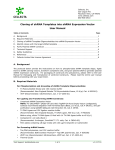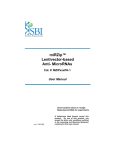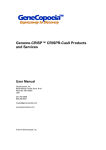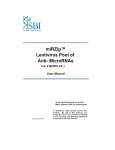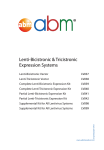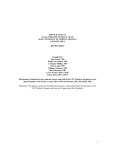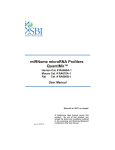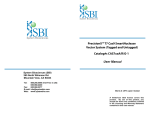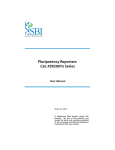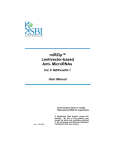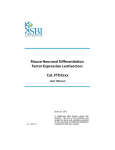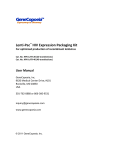Download PathNet Transcriptional Reporter Lentivectors User Manual
Transcript
PathNet™ Transcriptional Reporter Lentivectors Cat. #s TR100PA-1 – TR799PA-1 PathNet™ TRE Cloning Kits Cat. #s TR100A-1, TR500A-1 User Manual Store kit at -20°C on receipt (ver. 10-070201) A limited-use label license covers this product. By use of this product, you accept the terms and conditions outlined in the Licensing and Warranty Statement contained in this user manual. PathNet™ Plasmid Reporter Vectors PathNet™ TRE Cloning Kits Cat. #s TR100PA-1 – TR799PA-1 Cat. #s TR100A-1 – TR700A-1 Contents I. Introduction and Background A. B. C. D. E. F. Overview Lentiviral Transcriptional Reporter System Transcriptional Response Elements List of Components and TRE Sequences Additional Required Materials Safety Guidelines 2 2 4 5 7 8 II. Protocol A. Transcriptional Response Element Design and Synthesis B. Cloning of TRE into pTR Vector C. Identify Clones with TRE Inserts D. Testing of TRE Constructs 10 11 12 13 III. Troubleshooting 16 IV. References 18 V. Appendix A. B. C. D. E. F. G. H. I. Map of pTRF1-mCMV-dscGFP Vector Map of pTRH1-mCMV-dscGFP Vector Map of pTRF2-mCMV-Luc Vector Map of pTRH2-mCMV-Luc Vector pTRF1-mCMV-dscGFP Features Sequences of the primers used for clone identification Properties of dscGFP Fluorescent Protein Related Products Technical Support VI. Licensing and Warranty Statement 888-266-5066 (Toll Free) 650-968-2200 (outside US) 21 21 22 22 23 24 24 25 26 27 Page 1 System Biosciences (SBI) User Manual I. Introduction and Background A. Overview This manual provides details and information necessary to develop PathNet™ Transcriptional Reporter (TR) constructs in lentiviral vectors (pTRH1-mCMV-dscGFP and pTRF1-mCMV-dscGFP Reporter Vectors). Specifically, it provides instructions on designing and synthesizing Transcriptional Response Element (TRE) inserts, cloning TREs into the pTRH/pTRF Vectors, and confirming successful cloning. This manual does not include information on packaging pTRH or pTRF Vector constructs into pseudoviral particles or transducing your target cells of your choice with these particles. This information is available in the user manual provided with the Lentivector Packaging Kit from SBI (Multiple Cat. #s) which is available on the SBI web site (www.systembio.com). Before using the reagents and materials supplied with this system, please read the entire manual. B. Lentiviral Transcriptional Reporter System Advantages of lentivector technology include: • Ready-to-use pre-packaged constructs with a wide range of Transcriptional Response Elements (TREs) for multiple transcriptional factors. • Lentiviral reporter constructs can efficiently transduce nearly all cell types, even those that are difficult-to-transfect such as primary or non-dividing mammalian cells. • Our lentiviral-based reporter system is a novel approach to study transcriptional regulation and offers many advantages over current transcription reporter systems. TR constructs will integrate into the genome and therefore be subject to chromatin regulation (Leung, T.H., et.al., 2004). Expression of the reporter gene indicates activation of a given transcriptional response element (TRE) by the cognate transcriptional factor in the natural chromosomal environment rather than in the episomal state in the nucleoplasm as is the case for conventional plasmid-based TR vectors. Tandem copies of integration can be avoided, thus allowing for faithful promoter regulation. Copy number of reporter constructs can be controlled by varying the multiplicity of infection (MOI). • Construction of stable reporter cell lines is possible with TR lentivectors in just several days without the need for conventional, low efficiency selection of stable transfectants. • Monitoring of signaling pathways by flow cytometry (FACS) is enabled by GFP reporters. Page 2 ver. 10-070201 www.systembio.com PathNet™ Plasmid Reporter Vectors PathNet™ TRE Cloning Kits Cat. #s TR100PA-1 – TR799PA-1 Cat. #s TR100A-1 – TR700A-1 SBI’s basic PathNet™ TR lentivectors contain three different reporters (dscopGFP, Luciferase and β-Galactosidase) under the control of the minimum (m)CMV promoter. mCMV is not active without a TRE specific to a transcriptional factor (Figure 1). Vectors with mCMV can be used as negative controls in the experiment or as vectors for cloning any TRE of interest. After the introduction of a specific TRE upstream of mCMV, this construct becomes a fully active promoter and expression of the reporter gene depends on the activity of the specific TF (Figure 1). Fig. 1. Activity of the vectors depends on promoter sequence and presence of a specific transcriptional factor. TR vectors usually contain several repeats of specific transcriptional response elements (for Cat.#s see table below) to ensure efficient activation of the minimum promoter due to cooperative interaction between TF molecules. The pTR-dscGFP vectors contain a destabilized (ds) copGFP reporter gene under the CMV promoter and WPRE element. dscGFP is a novel fluorescent protein, derived from copepod plankton (Panalina sp.), which is similar to EGFP but has a brighter color (see Appendix). A unique feature of this protein is the presence of an additional destabilizing peptide on the C-end of the protein which shortens the half life time of the mature protein without additional transcription to 1 hour. The two other reporters (Luciferase and βGalactosidase) have codon usage optimized for translation in Human cells. C. Transcriptional Response Elements 888-266-5066 (Toll Free) 650-968-2200 (outside US) Page 3 System Biosciences (SBI) User Manual Unfortunately, TRE sequences for any transcriptional factor in different promoters are not conserved. TRE sequences can be found in the TRANSFAC professional Data Base (www.biobase.com) or in the public version of this Data Base (www.gene-regulation.com). Because each transcriptional factor has multiple TREs derived from different promoters we recommend to use a consensus sequence for each particular factor to make a reporter construct. However, this consensus sequence may not be the most efficient recognition element for all cell types. SBI transcriptional reporter vectors are designed for simple, rapid, and convenient assessment of the in vivo activation of signal transduction pathways. SBI has created a series of inducible reporter plasmids that contain three different reporter genes driven by a minimum CMV promoter plus a defined inducible response element (see Appendix). These plasmids are particularly suited for the in vivo readouts of signal transduction pathways since these TFs are convergent points of many signal transduction pathways. Because the lentiviral sequences are integrated into the genome, activation of reporter gene expression reflects changes in activity of the desired transcriptional factors in a natural chromatin environment, in comparison to commonly used plasmid transfection, most of which stay in the cytoplasm. These lentiviral systems are useful in studying the in vivo effects of a new gene, growth factor, or drug candidate on the signaling pathway. Basic reporters may also be used for cloning novel sequences in order to identify possible response elements. Figure 2. Analysis of p53 activity in HeLa cells transduced with different TR constructs. A. pTRH1-mCMV-dscGFP (negative control). B. pTRH1-CMVdscGFP (positive control). C. pTRH1-p53-dscGFP (basal level of p53). D. pTRH1-p53-dscGFP (p53 was activated by PRES-229 treatment). For your convenience, SBI provides control TR vectors and constructs for several TFs in ready-to-use form as pseudoviral particles. If you prefer to do the packaging step yourself, SBI supplies the packaging plasmids which can be purchased separately. Additional TF-specific constructs of your choice packaged in Page 4 ver. 10-070201 www.systembio.com PathNet™ Plasmid Reporter Vectors PathNet™ TRE Cloning Kits Cat. #s TR100PA-1 – TR799PA-1 Cat. #s TR100A-1 – TR700A-1 pseudoviral particles or provided as a plasmid are available as a custom service. D. List of Components PathNet™ Transcriptional Reporter Vector Cloning Kits: pTRF1-mCMV-dscGFP TRE Cloning Kit Cat. # TR100A-1 pTRH1-mCMV-dscGFP TRE Cloning Kit Cat. # TR500A-1 Component Conc. Amount 200 ng/μl 10 μg c-Fos TRE Ligation Control 100 nM 10 μl Forward (cPPT) PCR Primer 10 μM 50 μl Reverse2 (mCMV) PCR Primer 10 μM 50 μl pTR-mCMV-dscGFP FIV-Based PathNet™ Transcriptional Reporter Vectors (plasmid): dscGFP Reporter Vector pTRF1-mCMV-dscGFP pTRF2-CMV-dscGFP pTRF1-p53-dscGFP pTRF1-NFkB-dscGFP pTRF1-AP1-dscGFP pTRF1-cFos-dscGFP pTRF1-cJun-dscGFP pTRF1-FosB-dscGFP pTRF1-JunD-dscGFP pTRF1-DP1-dscGFP pTRF1-ErbA-dscGFP pTRF1-REVERB-dscGFP pTRF1-Sp1-dscGFP pTRF1-Sp3-dscGFP pTRF1-NMyc-dscGFP Catalog # TR100PA-1 TR101PB-1 TR102PA-1 TR103PA-1 TR104PA-1 TR105PA-1 TR106PA-1 TR107PA-1 TR108PA-1 TR109PA-1 TR110PA-1 TR111PA-1 TR112PA-1 TR113PA-1 TR114PA-1 Luciferase Reporter Vector pTRF3-CMV-Luc pTRF2-p53-Luc pTRF2-NFkB-Luc pTRF2-AP1-Luc pTRF2-cFos-Luc pTRF2-cJun-Luc pTRF2-FosB-Luc pTRF2-JunD-Luc pTRF2-DP1-Luc pTRF2-ErbA-Luc pTRF2-REVERB-Luc pTRF2-Sp1-Luc pTRF2-Sp3-Luc pTRF2-NMyc-Luc Catalog # TR201PC-1 TR202PB-1 TR203PB-1 TR204PB-1 TR205PB-1 TR206PB-1 TR207PB-1 TR208PB-1 TR209PB-1 TR210PB-1 TR211PB-1 TR212PB-1 TR213PB-1 TR214PB-1 All plasmids are shipped at a concentration of 200 ng/μl and an amount of 25 μg. All kits are shipped in dry ice and should be stored at -20°C upon receipt. Properly stored kits are stable for 12 months from the date received. For the complete list of available transcriptional reporter vectors, please visit our website at www.systembio.com 888-266-5066 (Toll Free) 650-968-2200 (outside US) Page 5 System Biosciences (SBI) User Manual HIV-Based PathNet™ Transcriptional Reporter Vectors (plasmid): dscGFP Reporter Vector pTRH1-mCMV-dscGFP pTRH1-CMV-dscGFP pTRH1-p53-dscGFP pTRH1-NFkB-dscGFP pTRH1-AP1-dscGFP pTRH1-cFos-dscGFP pTRH1-cJun-dscGFP pTRH1-FosB-dscGFP pTRH1-JunD-dscGFP pTRH1-DP1-dscGFP pTRH1-ErbA-dscGFP pTRH1-REVERB-dscGFP pTRH1-Sp1-dscGFP pTRH1-Sp3-dscGFP pTRH1-NMyc-dscGFP Catalog # TR500PA-1 TR501PA-1 TR502PA-1 TR503PA-1 TR504PA-1 TR505PA-1 TR506PA-1 TR507PA-1 TR508PA-1 TR509PA-1 TR510PA-1 TR511PA-1 TR512PA-1 TR513PA-1 TR514PA-1 Luciferase Reporter Vector pTRH2-CMV-Luc pTRH2-p53-Luc pTRH2-NFkB-Luc pTRH2-AP1-Luc pTRH2-cFos-Luc pTRH2-cJun-Luc pTRH2-FosB-Luc pTRH2-JunD-Luc pTRH2-DP1-Luc pTRH2-ErbA-Luc pTRH2-REVERB-Luc pTRH2-Sp1-Luc pTRH2-Sp3-Luc pTRH2-NMyc-Luc Catalog # TR601PB-1 TR602PB-1 TR603PB-1 TR604PB-1 TR605PB-1 TR606PB-1 TR607PB-1 TR608PB-1 TR609PB-1 TR610PB-1 TR611PB-1 TR612PB-1 TR613PB-1 TR614PB-1 All plasmids are shipped at a concentration of 200 ng/μl and an amount of 25 μg. All kits are shipped in dry ice and should be stored at -20°C upon receipt. Properly stored kits are stable for 12 months from the date received. For the complete list of available transcriptional reporter vectors, please visit our website at www.systembio.com Page 6 ver. 10-070201 www.systembio.com PathNet™ Plasmid Reporter Vectors PathNet™ TRE Cloning Kits Cat. #s TR100PA-1 – TR799PA-1 Cat. #s TR100A-1 – TR700A-1 Transcriptional Response Elements (TREs) Transcriptional factor AP-1 C/EBPalpha c-Fos c-Jun c-Myc c-Rel DP-1 E2F+p107 E2F-1 E2F-4/DP-2 Egr-1 ErbA FosB HIF-1 HSF1 INF JunD Max1 NF-kB N-Myc p53 REVERB-alpha Sp1 Sp3 SRF YY1 Recognition element (TCAGTCAG)6 (TTACGTCA)6 (GGTGTAA)6 (GTGACGTCAC)6 (CGTGGTCGACCACGTGGTCGACCACGTGGTCGACCACGTGACCA)2 (GGGGAATCTCCCGGGGAATCTCCC)3 (ATTGGCGCGAAAtAAAAATTGGCGCGAAA)2 (TCGCGG)6 (TTTCCCGC)6 (GGTTTTCCCGCCTTTT)4 (CACCCCCAC)6 (TCAGGTCA)6 (TGTAATA)4 (TACGTG)4 (TCTAGAAG)6 (TTTCtcTTTCAG)5 (GGTGTAATA)6 (ACGTGGTCGACCACGTGGTCGACC)3 (GGGACTTTCC)4 (AACATCAGCCCCCCACGTGATACAACATCAGC)2 (ACATGTCCCAACATGTTGTCG)8 (AGGTCA)6 (6GGGGCGGCGC)6 (GGCCCTGCCCTC)3 (CCATATATGG)3 (CCAAATATGG)4 E. Additional Required Materials For vectors purchased in plasmid form, you will also need to purchase the appropriate pPACK Lentivector Packaging Kit (Cat. # LV100A-1 for FIV-based vectors and Cat. # LV500A-1 for HIV-based vectors) and the 293TN Producer Cell Line (Cat. # LV900A-1) or HEK 293T cells (ATCC, Cat. # CRL-11268) in order to package your reporter constructs into pseudoviral particles. The protocol for packaging and transduction of packaged pseudoviral particles is provided in the SBI Lentivector Expression Systems User Manual and manual for HEK 293T cells (ATCC, Cat. # CRL-11268). Packaging Plasmid Kit pPACKF1 pPACKH1 Origin FIV-based HIV-based Catalog # LV100A-1 LV500A-1 For Annealing TRE Oligonucleotides • 2X DNA Annealing Buffer (20mM Tris, pH 7.8; 100mM NaCl; 0.2mM EDTA) 888-266-5066 (Toll Free) 650-968-2200 (outside US) Page 7 System Biosciences (SBI) User Manual For Phosphorylation of Annealed Oligonucleotides • T4 Polynucleotide Kinase (Recommended: New England BioLabs T4 Polynucleotide Kinase, Cat. # M0201S) For Ligating and Transforming Reporter Vector Construct • T4 DNA Ligase and ligation reaction buffer (Recommended: New England BioLabs T4 DNA Ligase, Cat. # M0202S. Dilute to 5 U/μl with the provided 1X reaction buffer just before use) • Competent E. coli cells (RecA-) (Recommended: Invitrogen One Shot OmniMAX 2 T1 PhageResistant competent cells, Cat. # C8540-03) • Petri plates containing LB Agar media with 50 μg/ml Ampicillin For Screening Inserts and sequencing. • • • • Taq DNA polymerase, reaction buffer, and dNTP mix (Recommended: Clontech Titanium™ Taq DNA polymerase, Cat. # 639208) PCR machine Forward and reverse primers (see Appendix for the sequences). 2-3% 1X TAE Agarose gel For Purifying Reporter Vectors after Cloning • Plasmid purification kit (Recommended: QIAGEN Endotoxin-free Plasmid Maxi Kit, Cat. # 12362. The following combination of kits can be used for Midi scale preparation of endotoxin-free DNA: ¾ QIAfilter Plasmid Midi Kit, Cat. # 12243, and EndoFree Plasmid Buffer Set, Cat. # 19048 Please visit the QIAGEN website to download the specialized protocol that is not contained in the current user manual: ¾ http://www1.qiagen.com/literature/protocols/pdf/QP15.pdf F. Safety Guidelines Work with FIV-based and HIV-based lentiviral vectors falls within NIH Biosafety Level 2 criteria. For a detailed description of laboratory biosafety level criteria, consult the following pages on the Centers for Disease Control Office of Health and Safety Web site: http://www.cdc.gov/od/ohs/biosfty/bmbl4/bmbl4s3.htm http://www.cdc.gov/od/ohs/biosfty/bmbl4/bmbl4toc.htm Also, you should consult the health and safety guidelines and officers at your institution regarding use and handling of the lentiviral system. In addition, although the system itself has been designed to minimize Page 8 ver. 10-070201 www.systembio.com PathNet™ Plasmid Reporter Vectors PathNet™ TRE Cloning Kits Cat. #s TR100PA-1 – TR799PA-1 Cat. #s TR100A-1 – TR700A-1 possible risk, specific recombinant lentivector constructs may be potentially hazardous, depending on the nature of introduced insert (such as oncogenes, toxins, Transcriptional Response Element to tumor suppressor genes, etc.). For these reasons, it is critical to exercise due caution while working with recombinant lentiviruses. To ensure safe laboratory handling, you should thoroughly understand the biology of the lentiviral vectors and the specific modifications and design features of the SBI system with which you are working. The original FIV viral vector was developed by Eric M. Poeschla, David J. Looney, and Flossie Wong-Staal in UCSD (Poeschla 2003). Based on this original pFIV vector, the FIV-based pTRF Vectors for cloning and delivering TREs into cells were developed at SBI. These lentivectors have been modified to remove sequences that overlap with the packaging plasmid to minimize the possibility of homologous recombination and generation of selfreplicating viral sequences when co-transfecting these constructs into packaging cells. SBI’s lentivectors also have a deletion in the enhancer of the U3 region of 3’ ΔLTR to ensure self-inactivation of the lentiviral vector after transduction and integration of the sequences into the genomic DNA of the target cells. SBI’s pTRH lentivectors together with the pPACKH1 packaging plasmids comprises a third-generation HIV-1-based cloning vector system. These lentivectors are based on the vectors developed for gene therapy applications by Dr. J. G. Sodroski (US patent #5,665,577 and # 5,981,276). This system is designed to maximize its biosafety features including: • Deletion in the enhancer of U3 region of 3’LTR ensures selfinactivation of lentiviral construct after transduction and integration into genomic DNA of the target cells. • RSV promoter upstream of 5’LTR in pTRH expression vector allows efficient Tat-independent production of viral RNA, reducing the number of genes from HIV-1 that are used in this system. • Number of HIV-1 viral genes necessary for packaging, replication and transduction is reduced to three (gag, rev and pol), and these genes are expressed from different plasmids lacking packaging signals and significant homology to pSIH expression vectors, VSV-G expression vector, or each other to prevent generation of recombinant replication-competent virus. • None of the HIV-1 genes (gag, pol, rev) will be present in the packaged viral genome, as they are expressed from packaging plasmids lacking packaging signal—therefore, the lentiviral particles generated are replication-incompetent. • Pseudoviral particles will carry only the expression construct of your target gene. 888-266-5066 (Toll Free) 650-968-2200 (outside US) Page 9 System Biosciences (SBI) User Manual To avoid any possible contamination and maintain a clean laboratory environment we also recommend following these standard safety practices: • Wear double gloves, face protection, and lab coat at all times. • Perform work in a limited access area in a Biological Safety Cabinet Class II and post biohazard warning signs. • Minimize splashes or aerosols with careful pipetting. • Take precautions with needles, blades, etc. • Decontaminate work surfaces at least once a day and after any spill of viable material. • Decontaminate all cultures, stocks, and other biological wastes before disposal using approved decontamination methods, such as autoclaving. Before decontamination the biological materials should be placed in a sealed, durable, leak-proof container for transport from the laboratory. Page 10 ver. 10-070201 www.systembio.com PathNet™ Plasmid Reporter Vectors PathNet™ TRE Cloning Kits Cat. #s TR100PA-1 – TR799PA-1 Cat. #s TR100A-1 – TR700A-1 II. Protocol A. Transcriptional Response Element Oligonucleotide Design and Synthesis Typically, 4 or 5 repeats of TRE sequences of interest should be inserted upstream of the mCMV promoter for efficient activation of transcription. Although there is no standard rule for selecting TRE sequences for particular factor, we recommend using consensus sequences (for example, see http://bio.chip.org/mapper or http://mars.kribb.re.kr:8080/tfExplorer/ websites) or a TRE from a promoter for genes which are highly expressed in most cell types or tissues. You should also consider that the size of each recognition element may be different, but it is preferable to have them one or two helix turns apart, i.e. 11 or 22 nucleotides, in order to be located on the same side of the DNA helix. If necessary, add an extra spacer between TRE repeats to follow this rule. For each selected sequence, two complementary TRE oligonucleotides (a top and a bottom strand) need to be synthesized, then annealed before the phosphorylation and ligation steps. Below are guidelines for synthesis of the Transcriptional Response Element oligonucleotides: (1) A 50 nmol scale reaction for DNA oligonucleotide synthesis with regular desalting purification is sufficient for cloning into the TR lentivectors. (2) For the best cloning efficiency, we recommend using phosphorylated oligonucleotides which can typically be ordered from the supplier. Alternatively, you can phosphorylate the oligonucleotides after synthesis using T4 polynucleotide kinase. The phosphorylation protocol is provided below in step B.2. (3) In addition to the Transcriptional Response Element sequence, the oligonucleotide needs to include a 2- or 4-base sequence at the 5’ end of each oligonucleotide which will be complementary to the desired cloning sites in the pTR vector. Typically, we clone into the EcoR1 and Spe1 sites (see diagram below). These sequences form “sticky-ends” that facilitate ligation with the linear vector. The annealed sequences should have a doublestranded Transcriptional Response Element structure as shown in the following diagram. Top strand 5’- AATTNNNNNNNNNNNNNNNNNNN -3’ 3’NNNNNNNNNNNNNNNNNNNGATC -5’ Bottom strand 888-266-5066 (Toll Free) 650-968-2200 (outside US) Page 11 System Biosciences (SBI) User Manual B. Cloning of TRE into pTR Vector 1. Anneal TRE Oligonucleotides a. Dissolve the TRE oligonucleotides in an appropriate amount of deionized water to a final concentration of 1 μM. Prepare the ds TRE oligonucleotide as follows: b. 2.5 2.5 25.0 20.0 50.0 c. Top strand TRE oligonucleotide Bottom strand TRE oligonucleotide 2X Annealing Buffer Deionized water Total volume Heat the mixture to 95°C for 5 min in a thermocycler or heating block. Turn off the thermocycler or heating block and let it cool to room temperature. The annealed oligonucleotide (100 nM) is ready for the phosphorylation and ligation steps. Store the annealed oligonucleotides at -20°C until use. d. e. 2. μl μl μl μl μl Phosphorylate the Transcriptional Response Element Duplex Note: If your oligonucleotides are already phosphorylated, dilute them to 10 nM in 1X Annealing Buffer, skip this phosphorylation step, and proceed to ligation in step 3. For the insert-minus control, you may either follow step 2 or use 1 μl Annealing Buffer in step 3. a. Set up 10 μl phosphorylation reactions for each experimental TRE template as follows: 1 μl 1 1 6 1 10 μl μl μl μl μl Annealed ds TRE template oligos from step B.1 (100 nM) * 10X T4 Polynucleotide Kinase Buffer 10 mM ATP Deionized water T4 Polynucleotide Kinase (10 U/μl) Total volume * For the insert-minus control, use 1 μl 1X Annealing Buffer b. Incubate the phosphorylation reaction at 37°C for 30 minutes. c. Use 1 μl (10 nM) for the ligation step. Page 12 ver. 10-070201 www.systembio.com PathNet™ Plasmid Reporter Vectors PathNet™ TRE Cloning Kits 3. Cat. #s TR100PA-1 – TR799PA-1 Cat. #s TR100A-1 – TR700A-1 Ligate the TRE into pTR vector a. Set up 10 μl ligation reactions for each phosphorylated TRE template as follows: 2.5 1.0 1.0 4.5 1.0 10.0 μl μl μl μl μl μl Linearized Reporter Vector (20 ng/μl) Phosphorylated ds TRE template (step B2; 10 nM) ** 10X T4 DNA Ligase Buffer Deionized water T4 DNA ligase (5 U/μl) Total volume ** For controls, use insert-minus (from step B2) and positive ligation control TRE for c-Fos provided in the kit (Use 1 μl of positive ligation control TRE per reaction). b. 4. Incubate the ligation reaction at 16°C for 2-4 hrs. Transform E. coli with the ligation product a. b. c. For each experimental TRE template, use the whole volume of ligation reaction for transformation. Follow the manufacturer’s protocol for transforming the competent cells with each experimental and control TRE construct. Plate an appropriate amount of transfected cells on LB plates with 50 μg/ml ampicillin and grow overnight at 37°C. C. Identify clones with Transcriptional Response Element inserts 1. Prepare colony cultures a. Randomly pick up 10 well-separated colonies from each plate and grow each clone in 100 μl of LB Broth with 100 μg/ml ampicillin at 37°C for 2 hours with shaking. b. Take 1 μl of each bacteria culture for PCR screening (see C.2) and continue to grow the cells for another 6 hours. Store the bacterial culture at 4°C. c. 888-266-5066 (Toll Free) 650-968-2200 (outside US) Page 13 System Biosciences (SBI) 2. User Manual Screen for TRE template inserts in lentiviral construct Clones with TRE insert can be identify using the Forward cPPT PCR Primer and Reverse2 (mCMV) PCR Primer provided in the kit (see Appendix for the sequence of the primers). a. Prepare a PCR master as follows: 1 rxn 0.5 μl 0.5 μl 0.5 μl 2.5 μl 19.5 μl 0.5 μl 24.0 μl 10 rxn 5 μl 5 μl 5 μl 25 μl 195 μl 5 μl 240 μl Composition Forward (cPPT) PCR primer (10 μM) Reverse2 (mCMV) PCR primer (10 μM) 50X dNTP mix (10 mM of each) 10X PCR Reaction Buffer Deionized water Taq DNA polymerase (approx. 5 U/μl) Total volume b. Mix the master mix very well and aliquot 24 μl into each well of 96-well PCR plate or individual tubes. c. d. Add 1 μl of each bacterial culture from C.1 into each well or tube. Proceed with PCR using the following program: 94°C, 4 min 1 cycle 94°C, 0.5 min, then 68°C, 30 sec. 25 cycles 68°C, 3 min 1 cycle e. Take 5 μl of the PCR reaction and run it on a 2-3% agarose/EtBr gel in 1X TAE buffer. The expected size of the PCR product if there is no insert present is 277 bp for FIV-based copGFP vectors, 300 bp for FIV-based Luciferase vectors, 150 bp for HIV-based copGFP vectors, and 175 bp for HIV-based Luciferase vectors. With the positive control c-Fos insert, the size is an additional 74 bp. For positive clones with your insert, add the size of your insert to the appropriate size above. Grow a positive clone with TRE insert in an appropriate amount of LB-Amp Broth, and purify the TR construct using an endotoxin-free plasmid purification kit (see Section I.F). Confirm identity of TRE insert by sequence analysis of the pTR construct using the Forward cPPT PCR primer (for sequences, see Appendix, Section V.F). D. Testing of the TR constructs If you are planning to use SBI’s pTR Lentiviral Vectors for viral delivery, first screen the TRE constructs generated in section C to determine their effectiveness in the cells of interest. TR constructs Page 14 ver. 10-070201 www.systembio.com PathNet™ Plasmid Reporter Vectors PathNet™ TRE Cloning Kits Cat. #s TR100PA-1 – TR799PA-1 Cat. #s TR100A-1 – TR700A-1 can be tested as reporters in a cell based assay directly after transfection into an appropriate cell line in the same way as regular TR plasmids. To rapidly screen the lentiviral TRE constructs in plasmid form, you can deliver and express them in HeLa or HEK 293 cells using chemical transfection. For example, with these cells, the Lipofectamine™ Reagent (Invitrogen, Cat. # 18324-111) with Plus™ Reagent (Invitrogen, Cat. # 11514-015) system works well. Alternatively, you can use your target cells for this analysis. If you have already established a transfection method for your target cells, use your established conditions. If you do not have an established transfection protocol, we recommend you compare efficiencies of several transfection procedures (e.g., Invitrogen’s Lipofectamine™ 2000, Cat. # 11668-027, Clontech’s CLONfectin™, Cat. # 631301). For TRE activation studies using transfection, it is important to optimize the selected transfection protocol and then keep the parameters constant to ensure reproducible results. Once you identify a functional TRE construct, you can package this construct into lenti pseudoviral particles, and efficiently transduce it into any target cells of choice. For this purpose, you will need to purchase the pPACKF1 (for FIV-based pTRF constructs) or pPACKH1 (for HIVbased pTRH constructs) Lentivector Packaging Kit from SBI (see Appendix). Figure 3 schematically shows all steps which need to be performed in order to generate pseudoviral packaged Transcriptional reporter constructs. A detailed protocol with descriptions of each step can be found in the Lentivector Packaging Kit manual also available on SBI’s website (www.systembio.com). 888-266-5066 (Toll Free) 650-968-2200 (outside US) Page 15 System Biosciences (SBI) User Manual Fig. 3. Schematic presentation of the packaging procedure for pTR constructs and making of stable cell lines. The Lentivector Packaging Kit User Manual includes the procedural information for packaging the viral vector. This user manual is also available on the SBI web site (www.systembio.com). Although you can create stable transfectants with the lentiviral construct using standard transfection and selection protocols, transduction of the lentiviral TRE construct using packaged pseudoviral particles is the most efficient way to deliver TRE constructs in a wide range of cells, including dividing, non-dividing, and hard-to-transfect cells. Page 16 ver. 10-070201 www.systembio.com PathNet™ Plasmid Reporter Vectors PathNet™ TRE Cloning Kits Cat. #s TR100PA-1 – TR799PA-1 Cat. #s TR100A-1 – TR700A-1 III. Troubleshooting 1. Getting Few or No Clones Use positive ligation control If you did not use the positive control, repeat all steps (i.e. annealing, phosphorylation, and ligation) to check the quality of your reagents. Check design of the TRE insert Check the sequence of the Transcriptional Response Element oligonucleotides to ensure that, after top-bottom strand annealing, the ends present on both 5’ ends overhang for proper annealing with the restricted ends of the linearized pTR Vector. Also, confirm that the top and bottom strand sequences reverse complement each other. Check top-bottom strand annealing To ensure a high percentage (80%) of double-stranded DNA after annealing, check the concentration of TRE oligonucleotides using a spectrophotometer and mix equal molar amounts of each strand. For optimal annealing, turn off the thermocycler after denaturation and let the tubes cool down to room temperature. Evaluate 5 μl of annealed insert (from step II.B.1.e) using a 12% polyacrylamide gel and compare the band’s location with that of the original single-stranded oligonucleotides. Confirm oligonucleotides were correctly synthesized Verify the size of the oligonucleotides using a 12% native polyacrylamide gel. Check quality of T4 polynucleotide kinase and T4 DNA ligase Test the activity of your ligase and reaction buffer using a different vector and insert. Test the activity of T4 polynucleotide kinase by 32 P-γATP. Replace the labeling annealed oligonucleotides with reagents if they show poor activity. Ensure there are no ligation inhibitors present EDTA and high salt can inhibit ligation reactions. Make sure that your double strand oligonucleotide concentration is only 100 nM and that you dilute it at least 10-fold before adding it to the ligation reaction. Check the quality of the competent cells Handle the competent cells gently. Many cells can not be refrozen once thawed. The quality of the competent cell can be tested by transforming with any circular plasmid. 888-266-5066 (Toll Free) 650-968-2200 (outside US) Page 17 System Biosciences (SBI) User Manual Check antibiotic selection The plates used for cloning should contain 50-100 μg/ml ampicillin in the media. 2. No product was amplified from selected clones Confirm activity of the Taq DNA polymerase Test the activity of the enzyme reaction by amplifying a known sequence from any plasmid DNA. Replace the reagents if they demonstrate poor activity. Page 18 ver. 10-070201 www.systembio.com PathNet™ Plasmid Reporter Vectors PathNet™ TRE Cloning Kits Cat. #s TR100PA-1 – TR799PA-1 Cat. #s TR100A-1 – TR700A-1 IV. References Buchschacher, G.L., and Wong-Staal, F. (2000) Development of lentiviral vectors for gene theraphy for human diseases. Blood. 95:2499-2504. Burns, J.C., Friedmann, T., Driever, W., Burrascano, M., and Yee, J.K. (1993) Vesicular stomatitis virus G glycoprotein pseudotyped retroviral vectors: concentration to a very high titer and efficient gene transfer into mammalian and non-mammalian cells. Proc. Natl. Acad. Sci. USA. 90:8033-8034. Cann, A.J.(ed). (2000) RNA Viruses. A Practical Approach. Oxford Univ. Press. Dull, T., Zufferey, R., Kelly, M., Mandel, R.J., Nguyen, M., Trono, D., and Naldini, L. (1998) A third-generation lentivirus vector with a conditional packaging system. J. Virol. 72:8463-8471. Gould, D.J. and Favorov, P. (2003) Vectors for the treatment of autoimmune diseases. Gene Therapy 10:912-927. Lee, N.S., Dohjima, T., Bauer, G., Li, H., Li, M-J., Ehsani, A., Salvaterra, P., and Rossi, J. (2002) Expression of small interfering RNAs targeted against HIV-1 rev transcripts in human cells. Nature Biotechnol. 20:500-505 Morgan, R.A., Cornetta, K. and Anderson, W.F. (1990) Application of the polymerase chain reaction in retroviral-mediated gene transfer and the analysis of gene-marked human TIL cells. Hum. Gene Ther. 1:135-149. Pfeifer, A., Kessler, T., Yang, M., Baranov, E., Kootstra, N., Cheresh, D.A., Hoffman, R.M. and Verma, I.M. (2001) Transduction of liver cells by lentiviral vectors: Analysis in living animals by fluorescence imaging. Mol. Ther. 3:319322. Qin, X.F., An, D.S., Chen, I.S., and Baltimore, D. (2003) Inhibiting HIV-1 infection in human T cells by lentiviral-mediated delivery of small interfering RNA against CCR5. Proc. Natl. Acad. Sci. USA 100:183-188 Quinn, T.P., and Trevor, K.T. (1997) Rapid quantitation of recombinant retrovirus produced by packaging cell clones. Biotechniques 23:1038-1044. Sui, G., Soohoo, C. Affar, E.B., Gay, F., Forrester, W.C., and Shi, Y. (2002) A DNA vector-based RNAi technology to suppress gene expression in mammalian cells. Proc. Natl. Acad. Sci. U.S.A 99:5515-5520 Curran MA, Nolan GP. Nonprimate lentiviral vectors. Curr Top Microbiol Immunol. 2002; 261: 75-105. Curran MA, Nolan GP. Recombinant feline immunodeficiency virus vectors. Preparation and use. Methods Mol Med. 2002; 69: 335-50 Loewen N, Barraza R, Whitwam T, Saenz DT, Kemler I, Poeschla EM. FIV Vectors. Methods Mol Biol. 2003; 229: 251-71. 888-266-5066 (Toll Free) 650-968-2200 (outside US) Page 19 System Biosciences (SBI) User Manual Naldini L. Lentiviruses as gene transfer agents for delivery to non-dividing cells. Curr Opin Biotechnol. 1998 Oct; 9(5): 457-63. Sauter SL, Gasmi M. FIV vector systems. Somat Cell Mol Genet. 2001 Nov; 26(1-6): 99-129. Alisky JM, Hughes SM, Sauter SL, Jolly D, Dubensky TW Jr, Staber PD, Chiorini JA, Davidson BL. Transduction of murine cerebellar neurons with recombinant FIV and AAV5 vectors. Neuroreport. 2000 Aug 21; 11(12): 266973. Brooks AI, Stein CS, Hughes SM, Heth J, McCray PM Jr, Sauter SL, Johnston JC, Cory-Slechta DA, Federoff HJ, Davidson BL. Functional correction of established central nervous system deficits in an animal model of lysosomal storage disease with feline immunodeficiency virus-based vectors. Proc Natl Acad Sci U S A. 2002 Apr 30; 99(9): 6216-21. Crystal RG. Bad for cats, good for humans? Modified feline immunodeficiency virus for gene therapy. J Clin Invest. 1999 Dec; 104(11): 1491-3. Curran MA, Kaiser SM, Achacoso PL, Nolan GP. Efficient transduction of nondividing cells by optimized feline immunodeficiency virus vectors. Mol Ther. 2000 Jan; 1(1): 31-8. Derksen TA, Sauter SL, Davidson BL. Feline immunodeficiency virus vectors. Gene transfer to mouse retina following intravitreal injection. J Gene Med. 2002 Sep-Oct; 4(5): 463-9. Haskell RE, Hughes SM, Chiorini JA, Alisky JM, Davidson BL. Viral-mediated delivery of the late-infantile neuronal ceroid lipofuscinosis gene, TPP-I to the mouse central nervous system. Gene Ther. 2003 Jan; 10(1): 34-42. Price MA, Case SS, Carbonaro DA, Yu XJ, Petersen D, Sabo KM, Curran MA, Engel BC, Margarian H, Abkowitz JL, Nolan GP, Kohn DB, Crooks GM. Expression from second-generation feline immunodeficiency virus vectors is impaired in human hematopoietic cells. Mol Ther. 2002 Nov; 6(5): 645-52. Stein CS, Davidson BL. Gene transfer to the brain using feline immunodeficiency virus-based lentivirus vectors. Methods Enzymol. 2002; 346: 433-54. Browning MT, Schmidt RD, Lew KA, Rizvi TA. Primate and feline lentivirus vector RNA packaging and propagation by heterologous lentivirus virions. J Virol. 2001 Jun; 75(11): 5129-40. Curran MA, Kaiser SM, Achacoso PL, Nolan GP. Efficient transduction of nondividing cells by optimized feline immunodeficiency virus vectors. Mol Ther. 2000 Jan; 1(1): 31-8. Poeschla EM, Wong-Staal F, Looney DJ. Efficient transduction of nondividing human cells by feline immunodeficiency virus lentiviral vectors. Nat Med. 1998 Mar; 4(3): 354-7. Page 20 ver. 10-070201 www.systembio.com PathNet™ Plasmid Reporter Vectors PathNet™ TRE Cloning Kits Cat. #s TR100PA-1 – TR799PA-1 Cat. #s TR100A-1 – TR700A-1 Poeschla, E.M., Looney, D.J., and Wong-Staal, F. (2003) Lentiviral nucleic acids and uses thereof. US Patent NO. 6,555,107 B2 Dull, T., Zufferey, R., Kelly, M., Mandel, R.J., Nguyen, M, Trono, D. (1998) J. Virol.,72, 8463-8471 Miyoshi, H., Blomer, U., Takashi, M., Gage, F.N., Verma, I.M (1998), J.Virol., 72, 8150-8157. Zufferey, R., Donello, J.E., Trono, D., Hope, T.J. (1999), J.Virol., 73, 28862892 Ramezani, A., Hawley, T.S., Hawley, R.G. (2000) Mol. Ther., 2, 458-469 Leung, T.H., Hoffmann, A., Baltimore, D. 2004, Cell, v. 118, 453-464 888-266-5066 (Toll Free) 650-968-2200 (outside US) Page 21 System Biosciences (SBI) User Manual V. Appendix A. Map of pTRF1-mCMV-dscGFP Vector B. Map of pTRH1-mCMV-dscGFP Vector TRE Multiple Cloning Site EcoRI -----ClaI XbaI SpeI ----------- -----ATTTTATCGATGAATTCTAGAACTAGTTAGG TAAAATAGCTACTTAAGATCTTGATCAATCC Page 22 ver. 10-070201 www.systembio.com PathNet™ Plasmid Reporter Vectors PathNet™ TRE Cloning Kits Cat. #s TR100PA-1 – TR799PA-1 Cat. #s TR100A-1 – TR700A-1 C. Map of pTRF2-mCMV-Luc Vector D. Map of pTRH2-mCMV-Luc Vector 888-266-5066 (Toll Free) 650-968-2200 (outside US) Page 23 System Biosciences (SBI) User Manual E. pTRF1-mCMV-dscGFP Features Feature CMV-5' LTR gag RRE cPPT CMV promoter dscGFP WPRE 3' ΔLTR (ΔU3) SV40 Poly-A SV40 Ori pUC Ori AmpR Location* Function Hybrid CMV promoter-R/U5 long terminal repeat; 1-415 required for viral packaging and transcription 762-1011 Packaging signal Rev response element binds gag and involved in 1012-1143 packaging of viral transcripts Central polypurine tract (includes DNA Flap 1150-1390 region) involved in nuclear translocation and integration of transduced viral genome Human cytomegalovirus (CMV)--constitutive 1391-1740 promoter for transcription of dscGFP Copepod green fluorescent protein (similar to regular EGFP, but with brighter color) as a 1766-2566 reporter for the transfected/ transduced cells; a destabilizing (ds) peptide on the C-end shortens the half life time of the mature protein to 1 hour Posttranscriptional regulatory element which 2575-3164 enhances the stability of the viral transcripts Required for viral reverse transcription; selfinactivating 3' LTR with deletion in U3 region 3283-3498 prevents formation of replication-competent viral particles after integration into genomic DNA 3499-3630 Transcription termination and polyadenylation Allows for episomal replication of plasmid in 3639-3785 eukaryotic cells 4155-4828(C) Allows for high-copy replication in E. coli Ampicillin resistant gene for selection of the 4973-5833(C) plasmid in E. coli * The notation (C) refers to the complementary strand. Page 24 ver. 10-070201 www.systembio.com PathNet™ Plasmid Reporter Vectors PathNet™ TRE Cloning Kits Cat. #s TR100PA-1 – TR799PA-1 Cat. #s TR100A-1 – TR700A-1 F. Sequences of the primers used for identification of the positive clones with TRE insert (included only with PathNet™ TRE Cloning Kits) For FIV-based pTRF vectors: Forward (cPPT): 5’-AGAAGAGGTAGGATAGGAGGGATG-3’ Reverse2 (mCMV): 5’-CTGCTTATATAGACCTCCCACCGT-3’ For HIV-based pTRH vectors: Forward (cPPT): 5’-GGGGTACAGTGCAGGGGAAAGAAT-3’ Reverse2 (mCMV): 5’-CTGCTTATATAGACCTCCCACCGT-3’ G. Properties of the dscGFP Fluorescent Protein The pTR-dscGFP Vectors contain the full-length copGFP gene with optimized human codons for high level of expression of the fluorescent protein from the CMV promoter in mammalian cells. The copGFP marker is a novel natural green monomeric GFP-like protein from copepod (Pontellina sp.). The copGFP protein is a non-toxic, non-aggregating protein with fast protein maturation, high stability at a wide range of pH (pH 4-12), and does not require any additional cofactors or substrates. A unique feature of the dscGFP protein is the presence of an additional destabilizing (ds) peptide on the C-end of the protein which shortens the half life time of the mature protein without additional transcription to 1 hour. The copGFP protein has very bright fluorescence that exceeds at least 1.3 times the brightness of EGFP, the widely used Aequorea victoria GFP mutant. The copGFP protein emits green fluorescence with the following characteristics: emission wavelength max – 502 nm; excitation wavelength max – 482 nm; quantum yield – 0.6; extinction coefficient – 70,000 M-1 cm-1 Due to its exceptional properties, copGFP is an excellent fluorescent marker which can be used instead of EGFP for monitoring delivery of FIV constructs into cells. 888-266-5066 (Toll Free) 650-968-2200 (outside US) Page 25 System Biosciences (SBI) User Manual H. Related Products • PathNet™ Lentiviral Transcriptional Reporter Constructs (in Pseudoviral Packaged form) ¾ Many (see Section I.D, or visit our website for a current list of available TR packaged constructs) Provided in pre-packaged, ready-to-use pseudoviral particles, these HIV- and FIV-based reporter constructs allow you to transduce and analyze a wide variety of TF-specific constructs in a wide range of cells. Based on the highly efficient lentiviral system, the PathNet™ Transcriptional Reporter Vectors provide a convenient and cost-effective system to deliver and stably integrate sequences of your choice into the host genome. • PathNet™ Pooled TF Binding Site Library (in Plasmid form) (Cat. # TR550PA-1) After packaging the plasmid library into pseudoviral particles, transduce the packaged PathNet™ library into target cells, select target cells with a specific phenotype, and identify TREs and corresponding transcription factors which induce the specific changes in expression levels of the reporter gene. • pPACK Lentivector Packaging Kits ¾ FIV-Based: pPACKF1 Packaging Kit (Cat. # LV100A-1) ¾ HIV-Based: pPACKH1 Packaging Kit (Cat. # LV500A-1) Unique lentiviral vectors that produce all the necessary lentiviral proteins and the VSV-G envelope glycoprotein from vesicular stomatitis virus required to package pTR lentiviral constructs into pseudoviral particles. 293T cells (ATCC, Cat. # CRL-11268) transiently transfected with the Lentiviral Packaging Plasmid Mix and one of the pTR reporter vectors produce packaged pseudoviral particles containing a pTR-TRE-mCMV construct. • 293TN Producer Cell Line (Cat. # LV900A-1) The 293TN cell line is a highly transfectable derivative of the HEK293 cell line with constitutive expression of SV40 T-antigen and neo gene. Use with the pPACK Lentivector Packaging Kit to generate a high titer of pseudoviral particles containing your lentivector construct. • Lentivector Rapid Titer PCR Kit (Cat. # LV950A-1 [for human cells], LV951A-1 [for mouse cells]) Measure copy number (MOI) of integrated lentiviral constructs in genomic DNA of target cells after transduction with SBI’s PathNet™ vectors or with constructs made in any of SBI’s FIV or HIV-based lentivectors. Page 26 ver. 10-070201 www.systembio.com PathNet™ Plasmid Reporter Vectors PathNet™ TRE Cloning Kits I. Cat. #s TR100PA-1 – TR799PA-1 Cat. #s TR100A-1 – TR700A-1 Technical Support For more information about SBI products and to download manuals in PDF format, please visit our web site: http://www.systembio.com For additional information or technical assistance, please call or email us at: System Biosciences (SBI) 1616 North Shoreline Blvd. Mountain View, CA 94043 Phone: (650) 968-2200 (888) 266-5066 (Toll Free) Fax: (650) 968-2277 E-mail: General Information: [email protected] Technical Support: [email protected] Ordering Information: [email protected] 888-266-5066 (Toll Free) 650-968-2200 (outside US) Page 27 System Biosciences (SBI) User Manual VI. Licensing and Warranty Statement Limited Use License Use of the PathNet™ Transcriptional Reporter Lentivector (i.e., the “Product”) is subject to the following terms and conditions. If the terms and conditions are not acceptable, return all components of the Product to System Biosciences (SBI) within 7 calendar days. Purchase and use of any part of the Product constitutes acceptance of the above terms. The purchaser of the Product is granted a limited license to use the Product under the following terms and conditions: The Product shall be used by the purchaser for internal research purposes only. The Product is expressly not designed, intended, or warranted for use in humans or for therapeutic or diagnostic use. The Product may not be resold, modified for resale, or used to manufacture commercial products without prior written consent of SBI. This Product should be used in accordance with the NIH guidelines developed for recombinant DNA and genetic research. FIV Vector System This Product is for non-clinical research use only. Use of this Product to produce products for sale or for any diagnostic, therapeutic, clinical (including pre-clinical), veterinary or high throughput drug discovery purpose (the screening of more than 10,000 compounds per day) is prohibited. In order to obtain a license to use this product for these commercial purposes, contact The Regents of the University of California. This Product or the use of this Product is covered by U.S. Patent No. 6,555,107 owned by The Regents of the University of California. HIV Vector System This product is for non-clinical research use only. Use of this Product to produce products for resale or for any diagnostic, therapeutic, clinical, veterinary, or food purpose is prohibited. In order to obtain a license to use this Product for these commercial purposes, contact the Office of Research and Technology Ventures at the Dana-Farber Cancer Institute, Inc. in Boston, Massachusetts, USA. This Product or the use of this Product is covered by U.S. Patents Nos. 5,665,577 and 5,981,276 (and foreign equivalents) owned by the Dana-Farber Cancer Institute, Inc. WPRE Technology System Biosciences (SBI) has a license to sell the Product containing WPRE, under the terms described below. Any use of the WPRE outside of SBI’s Product or the Products’ intended use, requires a license as detailed below. Before using the Product containing WPRE, please read the following license agreement. If you do not agree to be bound by its terms, contact SBI within 10 days for authorization to return the unused Product containing WPRE and to receive a full credit. The WPRE technology is covered by patents issued to The Salk Institute for Biological Studies. SBI grants you a non-exclusive license to use the enclosed Product containing WPRE in its entirety for its intended use. The Product containing WPRE is being transferred to you in furtherance of, and reliance on, such license. Any use of WPRE outside of SBI’s Product or the Product’s intended use, requires a license from the Salk Institute for Biological Studies. Page 28 ver. 10-070201 www.systembio.com PathNet™ Plasmid Reporter Vectors PathNet™ TRE Cloning Kits Cat. #s TR100PA-1 – TR799PA-1 Cat. #s TR100A-1 – TR700A-1 This license agreement is effective until terminated. You may terminate it at any time by destroying all Products containing WPRE in your control. It will also terminate automatically if you fail to comply with the terms and conditions of the license agreement. You shall, upon termination of the license agreement, destroy all Products containing WPRE in you control, and so notify SBI in writing. This License shall be governed in its interpretation and enforcement by the laws of California. Contact for WPRE Licensing: The Salk Institute for Biological Studies, 10010 North Torrey Pines Road, La Jolla, CA 92037; Attn: Office for Technology Management; Phone: (858) 435-4100 extension 1275; Fax: (858) 450-0509. CMV Promoter The CMV promoter is covered under U.S. Patents 5,168,062 and 5,385,839 and its use is permitted for research purposes only. Any other use of the CMV promoter requires a license from the University of Iowa Research Foundation, 214 Technology Innovation Center, Iowa City, IA 52242. CopGFP Reporter This product contains a proprietary nucleic acid coding for a proprietary fluorescent protein(s) intended to be used for research purposes only. Any use of the proprietary nucleic acids other than for research use is strictly prohibited. USE IN ANY OTHER APPLICATION REQUIRES A LICENSE FROM EVROGEN. To obtain such a license, please contact Evrogen at [email protected]. SBI has pending patent applications on various features and components of the Product. For information concerning licenses for commercial use, contact SBI. Purchase of the product does not grant any rights or license for use other than those explicitly listed in this Licensing and Warranty Statement. Use of the Product for any use other than described expressly herein may be covered by patents or subject to rights other than those mentioned. SBI disclaims any and all responsibility for injury or damage which may be caused by the failure of the buyer or any other person to use the Product in accordance with the terms and conditions outlined herein. Limited Warranty SBI warrants that the Product meets the specifications described in the accompanying Product Analysis Certificate. If it is proven to the satisfaction of SBI that the Product fails to meet these specifications, SBI will replace the Product or provide the purchaser with a refund. This limited warranty shall not extend to anyone other than the original purchaser of the Product. Notice of nonconforming products must be made to SBI within 30 days of receipt of the Product. SBI’s liability is expressly limited to replacement of Product or a refund limited to the actual purchase price. SBI’s liability does not extend to any damages arising from use or improper use of the Product, or losses associated with the use of additional materials or reagents. This limited warranty is the sole and exclusive warranty. SBI does not provide any other warranties of any kind, expressed or implied, including the merchantability or fitness of the Product for a particular purpose. SBI is committed to providing our customers with high-quality products. If you should have any questions or concerns about any SBI products, please contact us at (888) 266-5066. © 2007 System Biosciences (SBI). 888-266-5066 (Toll Free) 650-968-2200 (outside US) Page 29

































